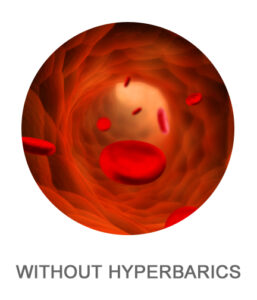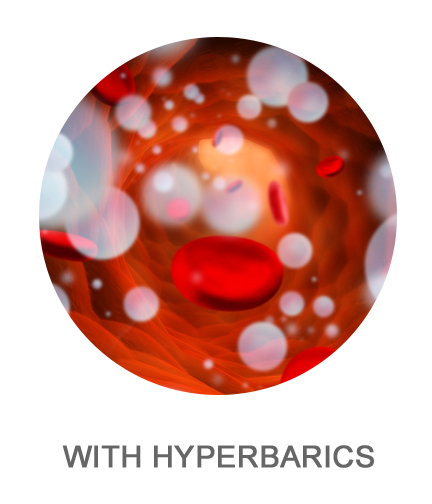 At sea level the atmospheric pressure is 1ATA (14.7 psi or pounds per square inch), which allows the lungs to absorb a normal amount of oxygen from the air. At higher altitudes, the pressure drops and the lungs are not able to absorb as much oxygen from the air. This is why oxygen masks drop in an airplane at high altitudes – to increase the oxygen content due to the lack of pressure. The exact opposite happens at lower altitudes (below sea level). There, the pressure is greater (above 1ATA) and now the lungs can more easily absorb the oxygen, and at a greater volume.
At sea level the atmospheric pressure is 1ATA (14.7 psi or pounds per square inch), which allows the lungs to absorb a normal amount of oxygen from the air. At higher altitudes, the pressure drops and the lungs are not able to absorb as much oxygen from the air. This is why oxygen masks drop in an airplane at high altitudes – to increase the oxygen content due to the lack of pressure. The exact opposite happens at lower altitudes (below sea level). There, the pressure is greater (above 1ATA) and now the lungs can more easily absorb the oxygen, and at a greater volume.
Hyperbaria is based on the concept of the relationship of gas pressure and uptake in liquids (blood, plasma and tissues). Henry’s Law states that “a gas is dissolved by a liquid in direct proportion to its partial pressure.” For example, at sea level, atmospheric pressure is 760 mm Hg, the oxygen concentration is 21% and the body’s oxygen content or partial pressure, pO2, in blood and plasma is ~ 40 mm Hg.
Red blood cells have a limitation as to how much oxygen can bind with hemoglobin. The plasma portion of the blood typically has about a 3% oxygen concentration.
By placing someone in a in a 3 psi pressure hyperbaric environment, the increase in atmospheric pressure at sea level goes from 760 mm Hg to 915 mm Hg. This increase in gas pressure, increases the partial pressure of the oxygen gas and thus forces more oxygen to be dissolved in the plasma. This saturation of oxygen in the blood, due to the Hyperbaric Oxygen Treatment or HBOT, allows the extra oxygen to be diffused or transported to the surrounding body tissues. Thus, oxygen transport by plasma is significantly increased under HBOT. At three atmospheres pressure, enough oxygen can be dissolved in the plasma to support the oxygen demands of the body at rest in the absence of hemoglobin!

Hyperbaric oxygen therapy is designed to boost the supply of oxygen to ischemic tissue or to diseased tissues that respond to increased oxygen levels. Increasing the volume of oxygen dissolved in the blood plasma produces five basic effects:
- Reduction of volume of gas bubbles in the blood
- Vasoconstriction, which reduces edema and secondary hypoxia
- Restoration of aerobic metabolism to ischemic tissue
- Detoxification of poisoned tissues
- Enhanced phagocytosis
Henry’s Law- Henry’s law states that for a gas-liquid interface the amount of the gas that dissolves in the liquid is proportional to its partial pressure. So Henry’s law helps to predict how much gas will be dissolved in the liquid. The actual amount also depends on the solubility of the gas as well as its partial pressure.
Dalton’s Law-John Dalton observed that the total pressure of a gas mixture was the sum of the pressures of each of the gases if they were to exist on their own.

 At sea level the atmospheric pressure is 1ATA (14.7 psi or pounds per square inch), which allows the lungs to absorb a normal amount of oxygen from the air. At higher altitudes, the pressure drops and the lungs are not able to absorb as much oxygen from the air. This is why oxygen masks drop in an airplane at high altitudes – to increase the oxygen content due to the lack of pressure. The exact opposite happens at lower altitudes (below sea level). There, the pressure is greater (above 1ATA) and now the lungs can more easily absorb the oxygen, and at a greater volume.
At sea level the atmospheric pressure is 1ATA (14.7 psi or pounds per square inch), which allows the lungs to absorb a normal amount of oxygen from the air. At higher altitudes, the pressure drops and the lungs are not able to absorb as much oxygen from the air. This is why oxygen masks drop in an airplane at high altitudes – to increase the oxygen content due to the lack of pressure. The exact opposite happens at lower altitudes (below sea level). There, the pressure is greater (above 1ATA) and now the lungs can more easily absorb the oxygen, and at a greater volume.